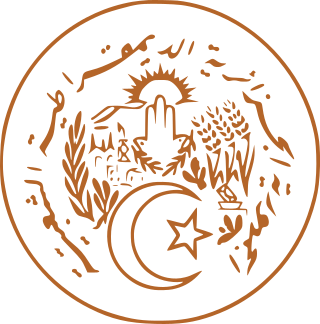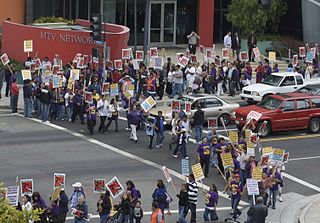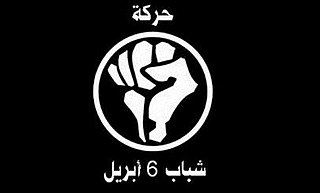
A protest is a public expression of objection, disapproval or dissent towards an idea or action, typically a political one. Protests can take many different forms, from individual statements to mass demonstrations. Protesters may organize a protest as a way of publicly making their opinions heard in an attempt to influence public opinion or government policy, or they may undertake direct action in an attempt to enact desired changes themselves. Where protests are part of a systematic and peaceful nonviolent campaign to achieve a particular objective, and involve the use of pressure as well as persuasion, they go beyond mere protest and may be better described as cases of civil resistance or nonviolent resistance.

Freedom of peaceful assembly, sometimes used interchangeably with the freedom of association, is the individual right or ability of people to come together and collectively express, promote, pursue, and defend their collective or shared ideas. The right to freedom of association is recognized as a human right, a political right and a civil liberty.
Free speech zones are areas set aside in public places for the purpose of political protesting. The First Amendment to the United States Constitution states that "Congress shall make no law ... abridging ... the right of the people peaceably to assemble, and to petition the Government for a redress of grievances." The existence of free speech zones is based on U.S. court decisions stipulating that the government may reasonably regulate the time, place, and manner – but not content – of expression.

A nonviolent revolution is a revolution conducted primarily by unarmed civilians using tactics of civil resistance, including various forms of nonviolent protest, to bring about the departure of governments seen as entrenched and authoritarian without the use or threat of violence. While many campaigns of civil resistance are intended for much more limited goals than revolution, generally a nonviolent revolution is characterized by simultaneous advocacy of democracy, human rights, and national independence in the country concerned.
The First Quarter Storm, often shortened into the acronym FQS, was a period of civil unrest in the Philippines which took place during the "first quarter of the year 1970." It included a series of demonstrations, protests, and marches against the administration of President Ferdinand Marcos, mostly organized by students, from January 26 to March 17, 1970.

In 2011, Algerian president Abdelaziz Bouteflika, who had been in power since 1999, lifted a state of emergency that had been in place since the end of the Algerian Civil War in 2002, as a result of the Arab Spring protests that had occurred throughout the Arab world.

Lesbian, gay, bisexual and transgender (LGBT) people in Georgia face legal challenges that non-LGBT people do not experience. Georgia is one of only a few countries in the former Soviet space that directly prohibits discrimination against all LGBT people in legislation, labor-related or otherwise. Since 2012, Georgian law has considered crimes committed on the grounds of one's sexual orientation or gender identity an aggravating factor in prosecution. Despite this, homosexuality is still considered a major deviation from highly traditional Orthodox Christian values prevalent in the country, where public discussions of sexuality in general tend to be viewed in a highly negative light. Consequently, homosexuals are often targets of abuse and physical violence, often actively encouraged by religious leaders.
Civil resistance is political action that relies on the use of nonviolent resistance by civil groups to challenge a particular power, force, policy or regime. Civil resistance operates through appeals to the adversary, pressure and coercion: it can involve systematic attempts to undermine or expose the adversary's sources of power, both domestic and international. Forms of action have included demonstrations, vigils and petitions; strikes, go-slows, boycotts and emigration movements; and sit-ins, occupations, and the creation of parallel institutions of government. Some civil resistance movements' motivations for avoiding violence are generally related to context, including a society's values and its experience of war and violence, rather than to any absolute ethical principle. Cases of civil resistance can be found throughout history and in many modern struggles, against both tyrannical rulers and democratically elected governments. Mahatma Gandhi was the first to use it to free India from British imperialism. The phenomenon of civil resistance is often associated with the advancement of democracy.
Freedom of assembly in the Russian Federation is granted by Art. 31 of the Constitution adopted in 1993:
Citizens of the Russian Federation shall have the right to gather peacefully, without weapons, and to hold meetings, rallies, demonstrations, marches and pickets.

Angola has long been severely criticized for its human rights record. A 2012 report by the U.S. Department of State said, "The three most important human rights abuses [in 2012] were official corruption and impunity; limits on the freedoms of assembly, association, speech, and press; and cruel and excessive punishment, including reported cases of torture and beatings as well as unlawful killings by police and other security personnel. Other human rights abuses included: harsh and potentially life-threatening prison conditions; arbitrary arrest and detention; lengthy pretrial detention; impunity for human rights abusers; lack of judicial process and judicial inefficiency; infringements on citizens' privacy rights and forced evictions without compensation; restrictions on nongovernmental organizations; discrimination and violence against women; abuse of children; trafficking in persons; discrimination against persons with disabilities, indigenous people, and persons with HIV/AIDS; limits on workers' rights; and forced labor."

A series of mass protests were held in Armenia in the wake of the Armenian presidential election of 19 February 2008. Mass protests against alleged electoral fraud were held in the capital city of Yerevan and organised by supporters of the unsuccessful presidential candidate and first President of Armenia, Levon Ter-Petrosyan.

The right to protest may be a manifestation of the right to freedom of assembly, the right to freedom of association, and the right to freedom of speech. Additionally, protest and restrictions on protest have lasted as long as governments have.

HIMA!, is a youth initiative in Yerevan, Armenia, advocating democracy and civil rights against the oppression of the authoritarian regime of Armenia’s former President Robert Kocharyan and his hand-picked successor, Serge Sargsyan.

The April 6 Youth Movement(Arabic: حركة شباب 6 أبريل) is an Egyptian activist group established in Spring 2008 to support the workers in El-Mahalla El-Kubra, an industrial town, who were planning to strike on 6 April.
The 2011 Azerbaijani protests were a series of demonstrations held to protest the government of President Ilham Aliyev. Common themes espoused by demonstrators, many of whom are affiliated with Müsavat and the Popular Front Party, the main opposition parties in Azerbaijan, include doubts as to the legitimacy of the 2008 presidential election, desire for the release of political prisoners, calls for democratic reforms, and demands that Aliyev and his government resign from power. Azerbaijani authorities have responded with a security crackdown, dispersing protests and curtailing attempts to gather with force and numerous arrests.

The Peaceful Assembly Act 2012 is the law which regulates public protests in Malaysia. According to the Barisan Nasional government, the Act allows citizens to organise and participate in assemblies peaceably and without arms, subject to restrictions deemed necessary and in the interest of public order and security.

Srđa Popović is a Serbian political activist. He was a leader of the student movement Otpor! that helped topple Serbian president Slobodan Milošević. After briefly pursuing a political career in Serbia, he established the Centre for Applied Nonviolent Action and Strategies (CANVAS) in 2003 and published Blueprint for Revolution in 2015. CANVAS has worked with pro-democracy activists from more than 50 countries, promoting the use of non-violent resistance in achieving political and social goals.

The 2019 Baku protests were a series of nonviolent rallies on 8, 19 and 20 October in Baku, the capital of Azerbaijan. The protests on 8 and 19 October were organized by the National Council of Democratic Forces (NCDF), an alliance of opposition parties, and called for the release of political prisoners and for free and fair elections. They were also against growing unemployment and economic inequality. Among those detained on 19 October was the leader of the Azerbaijani Popular Front Party, Ali Karimli.

Since April 2020, when Germany's Constitutional Court ruled that the governmental lockdown imposed in March to counter the COVID-19 pandemic did not allow blanket bans on rallies, several protests have been held in Germany against the two lockdowns and other anti-pandemic regulations. The protests attracted a mix of people from varied backgrounds, including supporters of populist ideas who felt called to defend against what they saw as an arrogant central government; supporters of various conspiracy theories; and sometimes far right-wing groups. Anti-vaxxers generally also formed a major part of the protesters. Some protesters held strongly negative views towards public media, who they believed to report in an unfair manner; repeatedly, journalists covering the rallies were subjected to harassment and physical attacks. Such attacks were the main reason why Germany slipped from eleventh to 13th place in the Press Freedom Index of Reporters Without Borders, according to a report published on 20 April 2021.
The 1989–1990 protests in Ivory Coast was massive violent demonstrations and a popular uprising that sprang up in Ivory Coast or Côte d'Ivoire in late-1989 to mid-1990, inspired by the 1989–1990 unrest in Benin against the government, low salaries and more.























